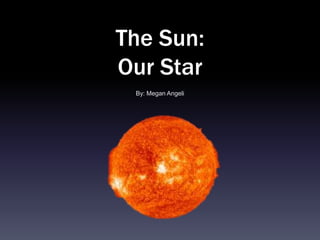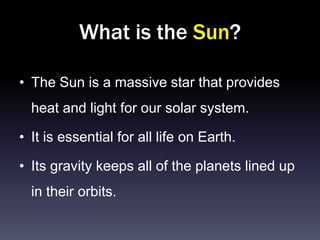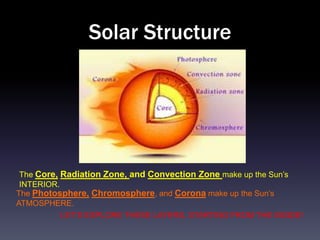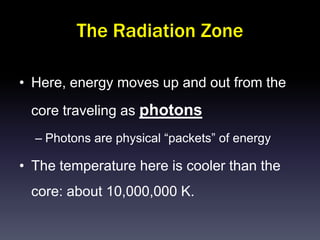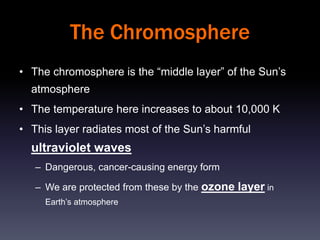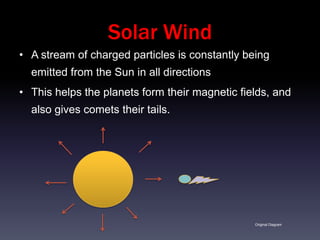The Sun: Our Star
- 1. The Sun: Our Star By: Megan Angeli
- 2. What is the Sun? • The Sun is a massive star that provides heat and light for our solar system. • It is essential for all life on Earth. • Its gravity keeps all of the planets lined up in their orbits.
- 3. How big is the Sun? • The Sun is 1000 times more massive than all the planets put together! • If we built a scale model of our solar system with the Sun as a grapefruit, the Earth would be the size of a pinhead orbiting about 15 meters away!
- 4. What is the Sun made up of? • The Sun is made up of burning, churning hot gas, also known as plasma. • The different properties of plasma, such as temperature and density, create various layers within the Sun’s structure.
- 5. Solar Structure The Core, Radiation Zone, and Convection Zone make up the Sun’s INTERIOR. The Photosphere, Chromosphere, and Corona make up the Sun’s ATMOSPHERE. LET’S EXPLORE THESE LAYERS, STARTING FROM THE INSIDE!
- 6. The Core • The core is the source of the Sun’s energy. • Energy is created through a process called Nuclear Fusion: – Atoms can travel so fast that when they collide, they “fuse” together and release energy – Hydrogen atoms within the Sun fuse to form Helium and release energy we receive as heat and light • Temperature: 15,000,000 K
- 7. The Radiation Zone • Here, energy moves up and out from the core traveling as photons – Photons are physical “packets” of energy • The temperature here is cooler than the core: about 10,000,000 K.
- 8. The Convection Zone • Convection is a process in which warmer, less dense matter rises, and cooler, more dense matter sinks. • As a result of convection, the energy in this layer moves up with warmer plasma and sinks with cooler plasma. • Cools down to 5,000,000 K in this layer
- 9. The Photosphere • The photosphere is the visible surface of the Sun. • This surface turns and churns like a pot of rapidly boiling water. • This layer has sunspots – Parts of the Sun’s surface get interrupted by intense magnetic fields and appear as blackened spots in camera images of the Sun • Temperature in this first layer of the Sun’s atmosphere dramatically decreases to about 6000 K
- 10. The Chromosphere • The chromosphere is the “middle layer” of the Sun’s atmosphere • The temperature here increases to about 10,000 K • This layer radiates most of the Sun’s harmful ultraviolet waves – Dangerous, cancer-causing energy form – We are protected from these by the ozone layer in Earth’s atmosphere
- 11. The Corona • This is the outermost layer of the Sun’s atmosphere • Extends millions of kilometers above the Sun’s visible surface • Creates large outer “envelope” of extremely high- temperature and low- density gas • The temperature here dramatically increases to about 1,000,000 K
- 13. Solar Wind • A stream of charged particles is constantly being emitted from the Sun in all directions • This helps the planets form their magnetic fields, and also gives comets their tails. Original Diagram
- 14. Solar Prominences • Gases from the corona & chromosphere get trapped in giant loops of magnetic activity • These loops extend up to 100,000 km above the surface for days or even weeks.
- 15. Solar Flares • The magnetic lines causing prominence loops can “snap” and violently release the trapped contents • The result is a solar flare that shoots deadly X-Rays into interstellar space
- 16. Sources • Information – Bennett, Jeffrey, Megan Donahue, and Nicholas Schneider. The Essential Cosmic Perspective. 6th ed. Pearson Addison-Wesley, 2012. 286-303. Print. • Images – Slide 1: science.nasa.gov – Slide 5: library.thinkquest.org – Slide 14: sciencephoto.com – Slide 15: mnn.com
